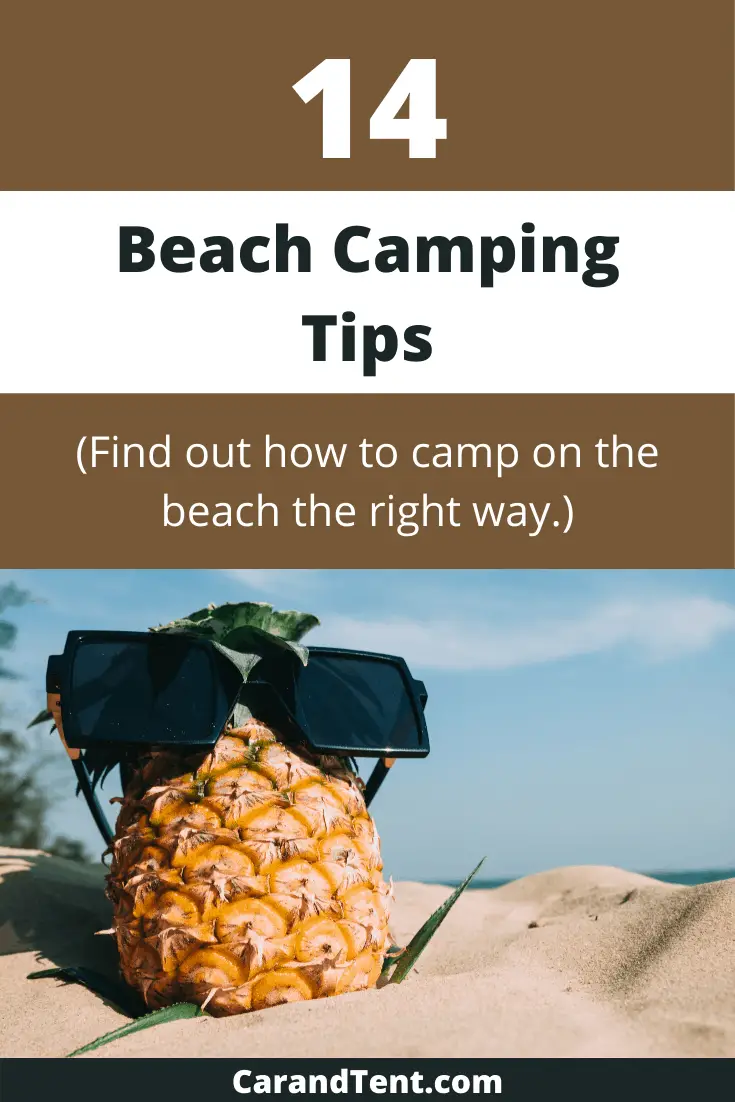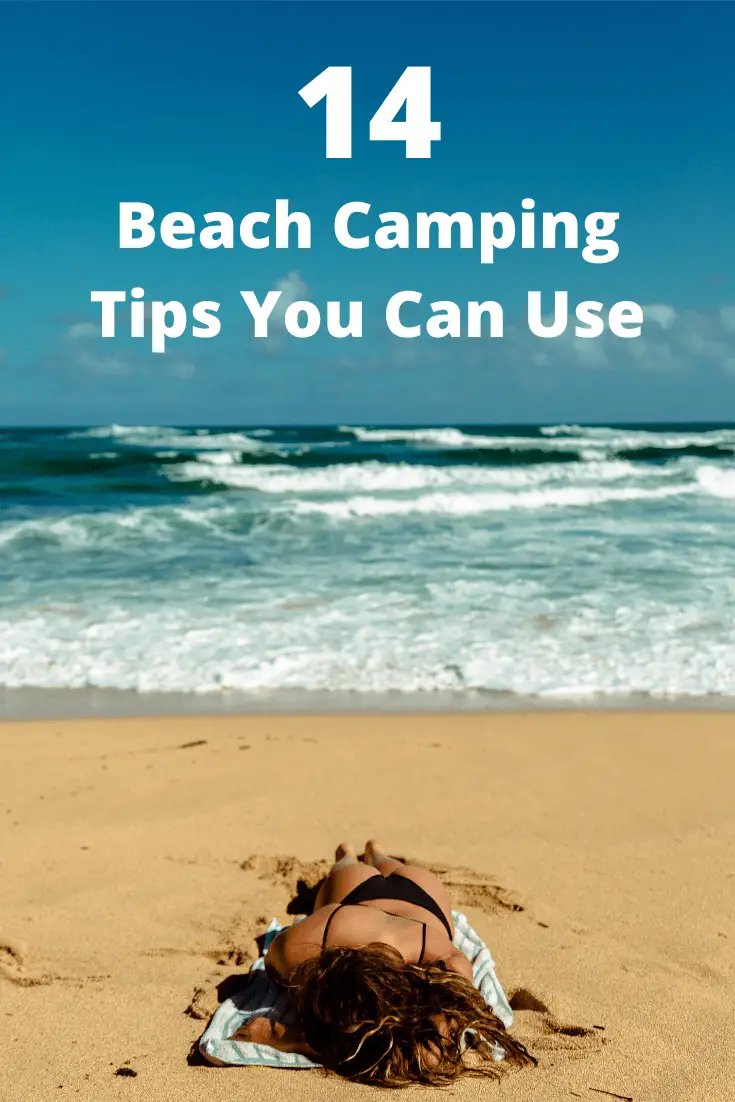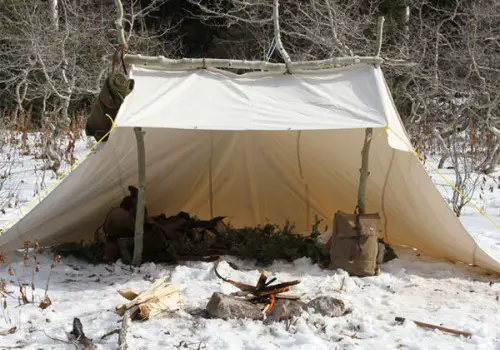My first camping trip to the beach was with friends who sort of knew how to camp on the beach, or at least they knew more than I did at the time. We were in our 20’s and we went to the beach mostly to drink beers and go surf fishing and camping was just a side benefit.
It was on a busy camping beach in Maryland so there weren’t many safety risks and we all had a good time and a good hangover to take home with us. Since then, I’ve switched my focus more to camping on the beach rather than to drinking on the beach and I’ve learned a lot.
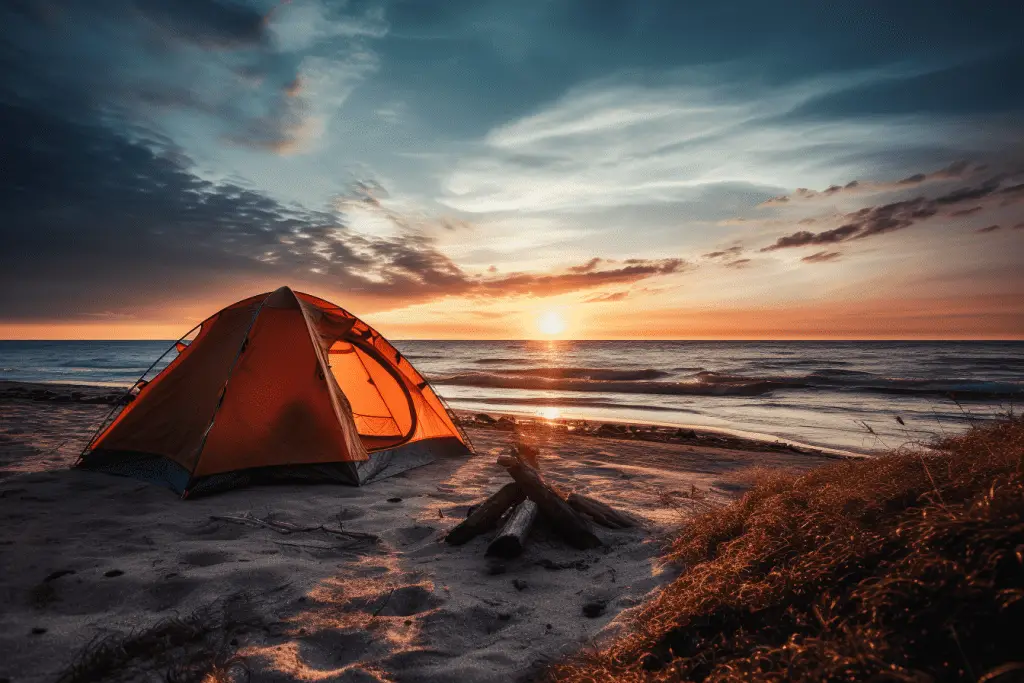
Here are my tips for how to camp on the beach – the right way.
- Get your vehicle ready for the trip.
- Pack sandbags and a shovel.
- Be prepared for humidity, cold weather, and heavy winds.
- Set-up camp away from high tide.
- Bring multiple tools for getting sand off of your gear.
- Get a pair of aquatic hiking shoes.
- Bring bug and insect repellants.
- Pack more food than you normally eat.
- Stay out of the water at dusk and after dark.
- Bring a beach tent, sun awning or tarp.
- Protect your food from animals.
- Protect your fire from high winds.
- Watch for lightning.
- Bring lots of ziplock bags.
1. Get your vehicle ready for the trip.
The best beach vehicles are four-wheel drive vehicles with a lot of ground clearance but all-wheel-drive vehicles will often suffice. Some beaches are easier to drive on than others so you may even be able to get away with any vehicle but it really depends on the surface you’ll be driving on.
Hard packed beaches are easy to drive on while soft and unlevel beaches are not.
Some of the beaches I’ve been on required you to let some air out of your tires. Letting air out of your tires expands the amount of tire that is within contact of the ground at any given time and provides additional traction. Because of this, you’ll need to bring an air pump so you can let air in and out of your tires before and after driving on the beach.
Here are some other items you’ll want to put in your car.
- A full-size spare tire.
- Tools for changing your tire.
- A 1’x1′ board to place your jack on.
- Tow straps.
- Extra coolant.
- Extra oil.
- Extra fuel if driving long distances.
- Extra water.
Also, be sure that your windshield wiper fluid container is full as you’ll probably need to use it on your way out.
While we’re on the subject of vehicles, be sure to park yours as far away from the water as possible. Parking too close to high tide probably isn’t going to result in it getting pulled out to see but it could end in your vehicle getting stuck in the sand. If this happens, you’ll end up needing those tow straps and another vehicle to get you out.
Clean your car’s air filters out when you get home as they probably have sand in them.
2. Pack sandbags and a shovel.
It can be difficult to set up tents and awnings on the beach. Using stakes on sand isn’t always easy and sand can often shift. On top of that, you’ll be dealing with heavy winds so a properly staked tent is a must.
Pack empty sandbags and a shovel so that you can fill the sandbags up when you get to your campsite. If you’re car camping, any good shovel will do. If you’re backpacking or packing everything into a small vehicle, think about packing a folding shovel or multi-tool.
Here is how you’ll set up your tent on the beach.
- Fill sandbags up.
- Erect your tent.
- Dig holes to bury your tent stakes in.
- Bury your tent stakes and place sandbags overtop of them.
- Dig a small trench around your tent.
Taking the time to set up correctly will help keep your tent safe from the wind and the water. Burying and bagging your stakes will keep the tent stable and digging a small trench will stop the rain from flooding your tent.
*The trench is not meant to protect you against high tide.
3. Be prepared for humidity, cold weather, and heavy winds.
Beach camping is similar to desert camping in that you may be dealing with hot weather during the day and cold weather during the night. You’ll also be dealing with heavy winds and a lot of sunshine without any shade. Pack appropriately.
Unlike desert camping, you’ll also be dealing with a lot of humidity. This means that you’ll want to stay away from clothing and gear that retains water. A synthetic sleeping bag will do much better than a down sleeping bag and fabric blends will do better than pure cotton clothing.
4. Set-up camp away from high tide.
Obviously, you don’t want high tide rushing in on you while you’re asleep but how do you know how far the tide comes in? In some state and national parks, they may have signs posted or you may be able to camp behind the dunes. If this is the case, then just follow the instructions.
In other areas, you’ll have to figure things out yourself. To do this, find out the times for high tide so that you can observe how far the tide comes in. Once you have this information it is easy to set your tent up behind this point.
If you don’t have tidal information, you may want to start out by looking at your surroundings. Look to see how far the water has come up in the past by looking for signs of trapped water or items that have clearly drifted in from the tide. Set up camp behind these areas and be prepared to move further back if necessary.
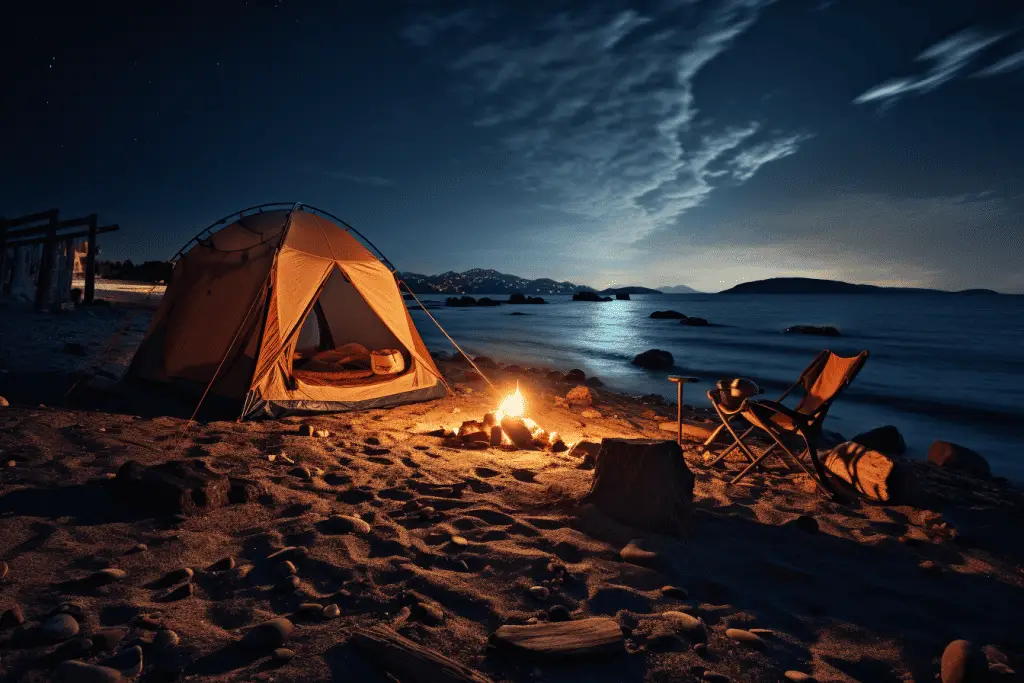
Beware of Storm Tides
Camping on the beach during a big storm is generally a bad idea.
Flash flooding can occur and even if it doesn’t, you can expect the ocean to come further inland than usual. When you’re on a backpacking trip or sea-canoe trip you may not have the luxury of being able to pack up and hop in your car to get away from a sudden storm.
If you find yourself camping on the beach with no way to safely leave, move your camp further inland. Yes, it is important to keep the dunes and the environment safe but it is also important to keep yourself safe. Just don’t stop directly on the dunes during a storm as the sand can quickly shift and the dunes could end up burying you.
5. Bring multiple tools for getting sand off of your gear.
Sand will be the bane of your existence when camping on the beach. Small dustpans and brooms can help you periodically clean up your tent and lint rollers can help you get sand off of zippers and gear.
Some people will create a “quarantine area” for sand directly in front of their tent. They’ll put down mats or tarps so that they can take their shoes off and leave behind gear at this spot rather than bringing the gear into their tent with them.
It also helps to get as much of your gear off of the ground as possible. If you’re car camping, you can pack cots and beach chairs to put everything on. Wilderness campers can bring tarps to reduce their time in the sand and keep gear off of it more often.
6. Bring a pair of aquatic hiking shoes and some old slippers.
Aquatic hiking shoes are better than sandals for hiking on the beach. These shoes have traction built into them and they come off and on easily. They also dry out fast and don’t retain sand afterward.
I have a pair of Tevas that I wear to the beach as well as other places where I might have to deal with sand, water, or mud. When I’m done hiking, I just hose them off and they are as good as new.
I also bring a pair of old slippers with me whenever I have room for them. Slippers are comfortable to wear around camp and they’ll be warmer than your aquatic shoes after the sun goes down.
7. Bring bug and insect repellants.
You may have gone to your local beach and been completely bug and insect-free. This probably won’t be the case when you visit a beach you can camp on.
Bugs and insects that you may have to deal with might include:
- Ticks
- Sand Fleas
- Horse Flies
- Gnats
- Mosquitos
Get a general spray for all of them that you can spray onto your gear and clothing. If possible, get a suntan lotion with a bug repellant to put on your body. You have to use sunscreen anyway so you might as well get one that serves two purposes.
8. Pack more food than you normally eat.
Lugging your gear around the beach, fighting the wind, swimming, going beach hiking, and setting up camp will all work to help you burn many more calories than usual. Unless you’re purposely trying to lose weight, go ahead and pack more food than you normally would.
The same holds true for packing water. When you go beach camping, you’ll most likely drink more water than when you go camping in the woods.
Packing additional food and water is especially important for those of you who are backpacking to your beach camping location. Hiking in the sand is much more difficult than hiking anywhere else and you’ll burn more calories and sweat more than you would on any other kind of hiking trip.
9. Stay out of the water at dusk and after dark.
Predators love dusk and dawn. This is when sharks and alligators feed and you don’t want to be in the water while they’re doing so. A bite from a shark or an alligator will quickly ruin any camping trip.
Going swimming after dark is also dangerous. Not only do you have predators to deal with but you also have limited vision. You could end up killing yourself in just a few feet of water just by tripping over a rock that you would have easily seen during the day.
Also, if the currents are strong, you may end up coming out of the water only to find that you’re nowhere near your campsite. If your tent isn’t very well lit, you might not be able to find your way back to camp at all until daybreak.
10. Bring a beach tent, sun awning, or tarp.
You’ll want to keep the sun off of you during the day. Awnings and beach tents are great for car and boat campers and tarps can be used for backpackers. If you have room for it, you may want to pack some form of netting to put around your sun awning or tarp. This way you’ll be able to keep the sun off of you and the insects away from you at once.
To put up your awning, just bury part of the legs in the sand and throw some sandbags around them. To put a tarp up in the wild, use ropes, stakes, and even driftwood to create a lean-to-type shelter.
11. Protect your food from animals.
Depending on what beach you go to you may still have to worry about bears. More than likely though, you’ll be dealing with smaller animals like raccoons and mice. These animals are quite resourceful and can get into food containers that you wouldn’t expect them to be able to deal with.
Some people bury their food containers but a better way to deal with this issue is to just bring a bear canister. Mice and raccoons aren’t going to be able to get into your bear canister and you can just leave it tied down or buried someplace away from your tent.
If you’re car camping in areas without bears, you may be able to just leave your food in your car. State and national parks that offer beach camping will have their own rules for food storage so just follow their recommendations and you’ll be fine.
12. Protect your fire from high winds.
The beach is windy and it can be hard to start and manage a campfire. Start your campfire with the help of cotton balls doused with vaseline. These are easy to pack in cars and in backpacks and they make getting the fire lit much easier.
Also, be sure to dig a firepit down into the sand so that your fire will have protection from the wind. This will help to keep the fire under control and will also help it to stay lit.
While we’re on the subject of fires, you might want to pack your own firewood. Some beaches will have plenty of wood laying about but most won’t. This is especially true on beaches that cater to a lot of campers each year.
13. Watch Out For Lightning
People who are on the beach are the second largest group of people who are likely to be killed by lightning. The first most likely group are people who are fishing and the third most likely group are people who are camping.
If you’ve decided to go camping on the beach so you can spend your days and nights fishing, you’re especially vulnerable to a lightning storm.
So what do you do when you’re camping on the beach during a lightning storm? If possible, get into your car, put your windows up, and don’t touch anything.
According to AccuWeather.com, “a fully-enclosed, all-metal vehicle is very safe”. It goes on to say that, “the lightning charge goes around the outside of the vehicle, creating a Faraday effect and protecting the occupants inside.” Most experts agree that your vehicle should not be on either.
If you’re not car camping on the beach you won’t have a car to retreat to. In this case, you’ll want to move to the low ground. Lightning is attracted to the highest point so moving to the low ground will cause other objects to be taller than you.
Of course, this could be dangerous too as the low ground might flood so use your best judgment. Also, don’t hold onto anything metallic as this will only act to further attract lightning to you.
14. Bring Ziplock Bags
One of the best safety tools you’ll have at your disposal is your cell phone. Keep your phone safe from sand and water by putting it in a ziplock bag when you’re not using it.
While you’re at it, put your other electronic devices in ziplock bags as well. If something happens to your phone you may be able to contact someone online with your tablet or laptop.
Besides, even if you’re not in any danger, who wants to get sand in their electronics?

